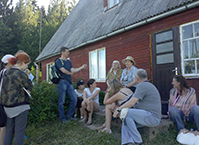About "black" potter's craft
Categories: Study and work, Peteris Gailums
“The black pots – it is neither specific glaze, nor particular clay. Simply the process of firing is slightly different. They are in the same way, you’ve seen, that there are dishes, which I have placed there, they as if slightly shine, that’s because they are very smooth. When they have been thrown, they have dried out, then you take some very very soft cloth, made of wool and then you polish that clay. We can say that in this way you close all the pores, as if you polish it. And then it is placed in the kiln. It is possible not to use any glaze at all. I can, I can, I use a bit of glaze, the glaze that is especially interesting is the one that is the copper glaze in a simple kiln, they will come out green, but in the black kiln they will be red. It happens, it is in scientific terms, oh, something comes out, the reduction process takes place. And then they are in the same way put into the kiln. In the same way, everything is covered with shards. In the same way, the kiln is stoked up to the same thousand – thousand and fifty degrees. When all that has been done, the kiln is left to cool. Let’s say for some half an hour, forty minutes. And then a great sheet of metal is put over. Now it is, I have taken it there, at that small kiln. So, a great sheet of metal is put over and then bricks are put on it to press that metal sheet to the kiln. And the simple clay, clay and sand are used to brick up everything, so that there is no, not even the smallest cranny. And then the whole furnace is filled with firewood and also closed with a sheet and also bricked up. There is no oxygen inside it anymore, it means that the firewood does not burn with flames anymore. What happens is the process that is very much alike the process of producing charcoal. And so, let’s say, it is in there, I haven’t seen what’s going on inside, right, but, that smoke absorbs into that clay at certain temperature. And it is not, as others think that, that they are simply as if smutty, but it is not true, that earthenware can be broken into halves and it will be all black inside.
And then, the next day, before taking the kiln out, that black kiln, then the bottom is opened and coal is quickly taken out, so that it doesn’t, doesn’t… get any draught, so that flames don’t appear there anymore or then they will again become red. This should be done. And then that’s all, the cover is taken off and the pots are taken out. But there is such an obligatory condition for black dishes that all of them, while they are still hot, edible oil is heated up with wax and all the dishes are soaked with it, we can say that they are soaked with it. The mix of oil and wax closes the smallest pores of clay and that dish would never leak, and the other, which is, especially if dishes are black, then, maybe, also there, nothing would go in, but if the hands become oily, go and take it, stains remain if it has not been treated sufficiently. If is treated with oil and wax, it thus pushes water off. And this is such a, so, those dishes must be treated.”
Images
Audio
Researcher: Dr. philol. Gatis Ozoliņš, Daugavpils Universitāte













